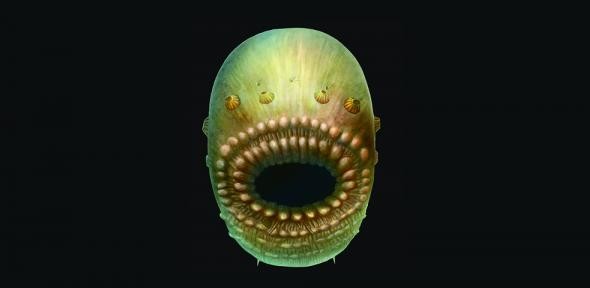By Ana Verayo, | January 31, 2017

This tiny sea creature is probably the earliest known ancestor of humans, at 540 million years old. (Jian Hian/University of Cambridge)
Scientists claim to have discovered the earliest human ancestor, otherwise known as the earliest organism where humans originated from some 540 million years ago. Apparently, it is a tiny, terrifying sac-like creature with no anus.
Scientists were able to find evidence of this mysterious animal in China's Shaanxi province, suggesting that humans began with this speck of a creature. The oldest fossils ever uncovered are about 3.5 billion years old called cyanobacteria, but they apparently belong to a different family branch.
Like Us on Facebook
Now, researchers from the University of Cambridge say that this terrifying, sac-like sea creature is humanity's first ancestor and not the 3.5 billion-year-old photosynthetic creature.
This new fossil is now known as Saccorhytus, and it is also the oldest deuterostome ever discovered. This group of animals consists of vertebrates like humans, and other creatures such as echinoderms are also marine animals like starfish.
Deuterostomes can be defined as possessing the ability to form embryos, specifically how embryos develop when tiny cells first form. This newly found primordial organism is such a tiny creature that it is estimated to be around a millimeter in size.
Scientists suggest that the Saccorhytus may have thrived in sea beds or within sand particles. Despite sounding like such a simple organism, under the microscope, its features possessed jaw-dropping details never seen before.
The Saccorhytus most distinct feature is its large mouth filled with concentric circles with raised circular bumps. Scientists say that this feature could be used for gulping food particles such as other microscopic organisms.
Researchers also conclude that despite its large mouth, this creature does not have a corresponding anus, suggesting that this is also where waste gets expelled.
Also, scientists say that the creature also has eight cone structures that could have been gills since water escaped from these slits. Scientists also say that the Saccorhytus also do not have eyes. This sac-like organism may have also moved around its habitat by wriggling its way out of the sea bed.
According to the author of the study, Simon Conway Morris of the University of Cambridge, this early deuterostome represents the primitive beginnings of many, diverse range of species including humans. This discovery is probably the first common ancestor of the deuterostomes.
This new study was published in the journal, Nature.
-
Use of Coronavirus Pandemic Drones Raises Privacy Concerns: Drones Spread Fear, Local Officials Say

-
Coronavirus Hampers The Delivery Of Lockheed Martin F-35 Stealth Fighters For 2020

-
Instagram Speeds Up Plans to Add Account Memorialization Feature Due to COVID-19 Deaths

-
NASA: Perseverance Plans to Bring 'Mars Rock' to Earth in 2031

-
600 Dead And 3,000 In The Hospital as Iranians Believed Drinking High-Concentrations of Alcohol Can Cure The Coronavirus

-
600 Dead And 3,000 In The Hospital as Iranians Believed Drinking High-Concentrations of Alcohol Can Cure The Coronavirus

-
COVID-19: Doctors, Nurses Use Virtual Reality to Learn New Skills in Treating Coronavirus Patients







